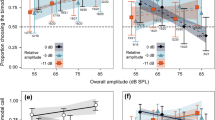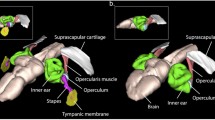Abstract
In many species of anurans, advertisement calls excite only one of the two inner-ear organs. One prediction of the pre-existing bias hypothesis is that signal innovations that additionally excite the “untapped” organ will be more behaviorally effective than normal calls. However, recent studies have shown that females of three species with single-peaked calls that stimulate only the basilar papilla (BP) preferred single-peaked synthetic calls with a frequency typical of conspecific calls to two-peaked calls that also stimulated the amphibian papilla (AP). We report that in spring peepers (Pseudacris crucifer) that also produce single-peaked calls, females did not show a preference in choices between single-peaked and two-peaked synthetic calls. Thus, the addition of energy exciting the AP had a neutral effect on signal attractiveness. Together, these results are unsupportive of the pre-existing bias hypothesis. An alternative hypothesis is that positive fitness consequences of responding to sounds providing extraordinary spectral stimulation are required for a novel call to become established as a mate-attracting signal. Testing these ideas requires a taxonomically broader examination of responses to sounds with novel spectral complexity, and attention to some methodological details will improve the comparability of such studies.

Similar content being viewed by others
References
Amézquita A, Hödl W, Lima AP, Castellanos L, Erdtmann L, De Araújo MC (2006) Masking interference and the evolution of the acoustic communication system in the Amazonian dendrobatid frog Allobates femoralis. Evolution 60:1874–1887
AmphibiaWeb (2012) AmphibiaWeb species numbers. The Regents of the University of California. http://amphibiaweb.org/amphibian/speciesnums.html. Accessed 18 Aug 2012
Arch VS, Grafe TU, Gridi-Papp M, Narins PM (2009) Pure ultrasonic communication in an endemic Bornean frog. PLoS One 4:e5413
Arnqvist G (2006) Sensory exploitation and sexual conflict. Phil Trans R Soc B Biol Sci 361:375–386
Bernal X, Rand AS, Ryan MJ (2007) Sexual differences in the behavioral response of túngara frogs, Physalaemus pustulosus, to cues associated with increased predation risk. Ethology 113:755–763
Bosch J, Boyero L (2003) Double stimulation of the inner ear organs of an anuran species (Alytes cisternasii) with simple tonal advertisement calls. J Zool Lond 260:347–351
Capranica RR, Moffatt AJM (1983) Neurobehavioral correlates of sound communication in anurans. In: Ewert JP et al (eds) Advances in vertebrate neuroethology. Plenum Press, New York, pp 701–730
Chek AA, Bogart JP, Lougheed SC (2003) Mating signal partitioning in multi-species assemblages: a null model test using frogs. Ecol Lett 6:235–247
Christensen-Dalsgaard J, Narins P (1993) Sound and vibration sensitivity of VIIIth nerve fibers in the frogs Leptodactylus albilabris and Rana pipiens pipiens. J Comp Physiol A 172:653–662
Diekamp BM, Gerhardt HC (1992) Midbrain auditory sensitivity in the spring peeper (Pseudacris crucifer): correlations with behavioral studies. J Comp Physiol A 171:245–250
Doherty JA, Gerhardt HC (1984) Evolutionary and neurobiological implications of selective phonotaxis in the spring peeper (Hyla crucifer). Anim Behav 32:875–881
Endler JA, Basolo AL (1998) Sensory ecology, receiver biases and sexual selection. Trends Ecol Evol 13:415–420
Feng AS, Narins PM, Xu CH, Lin WY, Yu ZL, Qiu Q, Xu ZM, Shen JX (2006) Ultrasonic communication in frogs. Nature 440:333–336
Gerhardt HC (1976) Significance of two frequency bands in long distance vocal communication in the green treefrog. Nature 261:692–694
Gerhardt HC (1981a) Mating call recognition in the green treefrog (Hyla cinerea): importance of two frequency bands as a function of sound pressure level. J Comp Physiol A 144:9–16
Gerhardt HC (1981b) Mating call recognition in the barking treefrog (Hylagratiosa): responses to synthetic calls and comparisons with Hyla cinerea. J Comp Physiol A 144:17–25
Gerhardt HC (1994) Reproductive character displacement of female mate choice in the grey treefrog, Hyla chrysoscelis. Anim Behav 47:959–969
Gerhardt HC (2005) Acoustic spectral preferences in two cryptic species of grey treefrogs: implications for mate choice and sensory mechanisms. Anim Behav 70:39–49
Gerhardt HC (2008) Phonotactic selectivity in two cryptic species of gray treefrogs: effects of differences in pulse rate, carrier frequency and playback level. J Exp Biol 211:2609–2616
Gerhardt HC, Huber F (2002) Acoustic communication in insects and anurans. University of Chicago Press, Chicago
Gerhardt HC, Schwartz JJ (2001) Auditory tuning and frequency preferences in anurans. In: Ryan MJ (ed) Anuran communication. Smithsonian Institution Press, Washington, pp 73–85
Gerhardt HC, Tanner SD, Corrigan CM, Walton HC (2000) Female preference functions based on call duration in the gray treefrog (Hyla versicolor). Behav Ecol 6:663–669
Gerhardt HC, Martinez-Rivera CC, Schwartz JJ, Marshall VT, Murphy CG (2007) Preferences based on spectral differences in acoustic signals in four species of treefrogs. J Exp Biol 210:2990–2998
Llusia D, Márquez R, Beltrán JF (2010) Non-selective and time-dependent behavioural responses of common toads (Bufo bufo) to predator acoustic cues. Ethology 116:1146–1154
Martin WF (1971) Mechanics of sound production in toads of the genus Bufo: passive elements. J Exp Zool 176:273–294
Neuhofer D, Wohlgemuth S, Stumpner A, Ronacher B (2008) Evolutionarily conserved coding properties of auditory neurons across grasshopper species. Proc R Soc Lond B 275:1965–1974
Rand S, Ryan MJ, Wilczynski W (1992) Signal redundancy and receiver permissiveness in acoustic mate recognition by the Túngara Frog, Physalaemus pustulosus. Am Zool 32:81–90
Richards CL (2006) Has the evolution of complexity in the amphibian papilla influenced anuran speciation rates? J Evol Biol 19:1222–1230
Ryan MJ, Rand AS (1990) The sensory basis of sexual selection for complex calls in the tungara frog, Physalaemus pustulosus (sexual selection for sensory exploitation). Evolution 44:305–314
Simmons DD, Meenderink SWF, Vassilakis PN (2007) Anatomy, physiology, and function of auditory end-organs in the frog inner ear. In: Narins PM et al (eds) Hearing and sound communication in amphibians. Springer, New York, pp 184–220
Wilcyznski W, Zakon HH, Brenowitz EA (1984) Acoustic communication in spring peepers—call characteristics and neurophysiological aspects. J Comp Physiol 155:577–584
Wilcyznski W, Rand AS, Ryan MJ (2001) Evolution of calls and auditory tuning in the Physalaemus pustulosus species group. Brain Behav Evol 58:137–151
Witte K, Ryan MJ, Wilczynski W (2001) Changes in the frequency structure of a mating call decrease its attractiveness to females in the cricket frog Acris crepitans blanchardi. Ethology 107:685–699
Zakon HH, Wilczynski W (1988) The physiology of the anuran eighth nerve. In: Fritzsch B et al (eds) The evolution of the amphibian auditory system. Wiley, New York, pp 125–155
Acknowledgments
We thank Mitch Tucker, Jennifer Henderson, Michael Reichert, Vincent Marshall, Brooke Aden, and Brittany Thometz for collecting female spring peepers, testing them, or both. Mark Bee and anonymous referees provided helpful comments on the manuscript. Protocols described for the care and use of animals in this study were approved by the Institutional Animal Care and Use Committee of the University of Missouri (#6545). This research was supported by the National Science Foundation (IBN0091993 and 1023973) and National Institutes of Health (DHHS R01 DC05760). HCG is grateful for the support of the Humboldt Foundation and the Hanse Wissenschaftskolleg.
Author information
Authors and Affiliations
Corresponding author
Rights and permissions
About this article
Cite this article
Gerhardt, H.C., Humfeld, S.C. Pre-existing sensory biases in the spectral domain in frogs: empirical results and methodological considerations. J Comp Physiol A 199, 151–157 (2013). https://doi.org/10.1007/s00359-012-0776-4
Received:
Revised:
Accepted:
Published:
Issue Date:
DOI: https://doi.org/10.1007/s00359-012-0776-4




